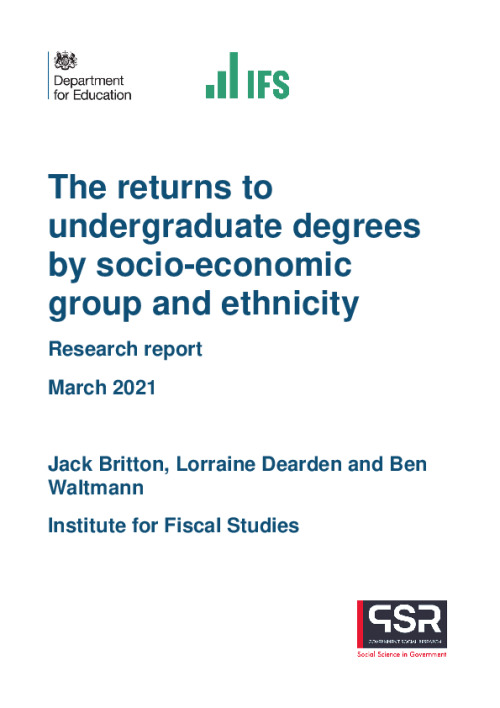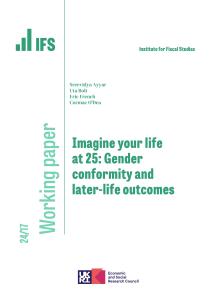We investigate differences in the returns to undergraduate degrees by socio-economic background and ethnicity using the Department for Education’s Longitudinal Education Outcomes (LEO) data set. The LEO data set links school records, university records and tax records for everyone who took GCSEs in England since 2002. Using these data, we can estimate returns up to age 30.
Our main findings are:
• Average returns to undergraduate degrees at age 30 are positive for people from all socioeconomic and ethnic groups we study, but there is substantial heterogeneity across groups. Returns are especially high for privately-educated graduates, whose median earnings at age 30 are the highest of all groups. However, we find that the groups with the lowest graduate earnings, such as Pakistani students or state-educated students from the poorest families, also have relatively high returns from going to university. The reason is that the earnings prospects of these groups are very low on average if they do not attend university.
• Besides high returns for privately educated students, returns vary relatively little by socio-economic status. At age 30, we find gross earnings returns of around 6% for stateeducated men and around 27% for state-educated women. If anything, returns are somewhat higher for state-educated students from the poorest 20% of families, with returns at around 7% for men and 31% for women. Returns for privately educated students are much higher at around 29% for men and 36% for women.
• By ethnicity, we see especially high returns for South Asian students. In particular, we find returns of 27% for Indian women, 40% for Pakistani women and 30% for Bangladeshi women, as well as 16% for Indian men, 36% for Pakistani men and 14% for Bangladeshi men. Strikingly, Pakistani graduates have the highest returns of all ethnic groups, even though they have the lowest median age-30 earnings at £23,000 for men and £19,000 for women.
• Returns for Black women are somewhat lower than for White British women. Estimated returns are 9% for Black Caribbean women, 20% for Black African women and 23% for Other Black women, compared with 28% for White British women. For Black men, estimated returns differ widely between different subgroups: returns for Black African men are large at 15%, but returns for Black Caribbean men are similar to returns for White British men at 7%, and returns for Other Black men are low at 4%.
• Some but not all of the differences in returns can be explained by variation in subjects chosen and institutions attended. Subject choice explains little of the variation in returns by socio-economic status, but a substantial amount of the variation in returns by ethnicity: Asian students systematically choose more lucrative subjects than White British students. Conversely, institution choices can partly explain why private school students get higher returns from university than those who attended state schools; however, institution choices do not explain much of the variation in returns by ethnicity.
• Unexplained differences in earnings between groups are mostly smaller among graduates than among non-graduates. This implies that differences in the returns to higher education ‘even out’ some of the earnings differences between non-graduates that cannot be explained by other factors. However, large unexplained earnings gaps between socio-economic and ethnic groups remain. In particular, controlling for background conditions, prior attainment, and university and subject choice, graduate men from all non-White ethnic groups earn significantly less than White British graduates.
We supplement these age-30 results with estimated discounted net lifetime returns in pounds for the different groups based on a simulation of lifetime earnings. This simulation is subject to a large amount of uncertainty, so the results should be treated with caution. We account for the effect of the tax and student loans system and we discount using Treasury Green Book discounting.
The main results are:
• Lifetime returns by socio-economic status follow a U shape. For women, the average return varies between £140,000 for the bottom quintile and £70,000 for the top state quintile. For men, the returns are similar to the estimates for women for the bottom four SES quintiles, but higher at around £110,000 for the top state SES quintile, while for the privately educated the returns are much higher at around £250,000.
• Lifetime returns by ethnicity follow a similar pattern to gross returns at age 30. Returns for South Asian students are relatively high at around £200,000 for men and around £170,000 for women. Estimated returns for Black students are relatively low at around £50,000; an exception is Black African women, for whom we estimate a lifetime return of £175,000 on average. White British, White Other, and Other students have middling returns of roughly £100,000 for both men and women.












